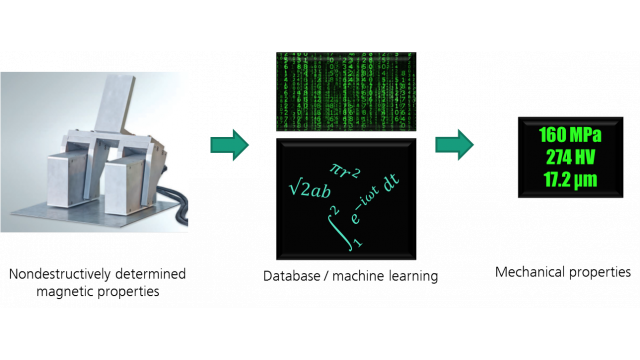Micromagnetic methods
Micromagnetic materials characterisation is based on the correlation between the magnetic properties of ferromagnetic materials and their mechanical-technological characteristics, which depend on the microstructure. Generally, micromagnetic measuring devices contain a magnetisation unit, a probe to capture the magnetic response of the material and a unit for measurement control and data processing (usually a PC). Depending on the design of the magnetisation unit as well on the measurement parameters, different material depths and areas can be investigated. Commercial micromagnetic NDT devices use different effects in order to describe the material condition. Within NOMAD the following methods based on several effects will be used:
Micromagnetic Multiparameter Microstructure and Stress Analysis (3MA) is a solution for the quantitative determination of target quantities such as hardness, hardening depth, DBTT, yield or ultimate strength. It is based on parameters derived from four micromagnetic analysis methods. An electromagnet in the 3MA probe excites an alternating magnetic field in the material to be analyzed. Under this excitation, the material shows micromagnetic effects which are registered with different magnetic field sensors inside the probe. The measured signals are further processed and analyzed in the software. Having performed all measurements and analyses, the device delivers a kind of “magnetic fingerprint“ to the PC. There, a quantitative and qualitative materials characterization (after previous calibration on a well-defined calibration set of samples with known target properties) is performed. In NOMAD, a special variant of this approach with fewer calibration effort will be developed.

Magnetic adaptive testing (MAT) is a recently developed method for nondestructive characterization of ferromagnetic materials based on systematic measurement and evaluation of minor magnetic hysteresis loops. The magnetizing unit is fed with a current of triangular waveform with stepwise increasing amplitudes and with a fixed slope magnitude in all the triangles. Prior to each measurement, the sample is locally demagnetized by triangular waveform decreasing current. The voltage signal collected by the in the pick-up coil is proportional to the magnetic permeability of material to be characterized. The raw data is a family of permeability loops, which is then processed by a special data evaluation program.
Micromagnetic Inductive Response & Barkhausen Emission (MIRBE) method is based on the magnetic induction changes over time and the analysis of the magnetic Barkhausen noise signal together with other electromagnetic quantities in different measurement modes. Two modes of measurement will be used: fixed excitation and scanning intensity mode. Of particular interest is the latter one, where the applied magnetic field intensity increases and signals are measured at each step of the increasing field, creating a signal versus applied intensity curve. Increasing magnetization field intensity allows obtaining the magnetic signature of the material at various points of the hysteresis curve, from near-coercivity to saturation regions.
